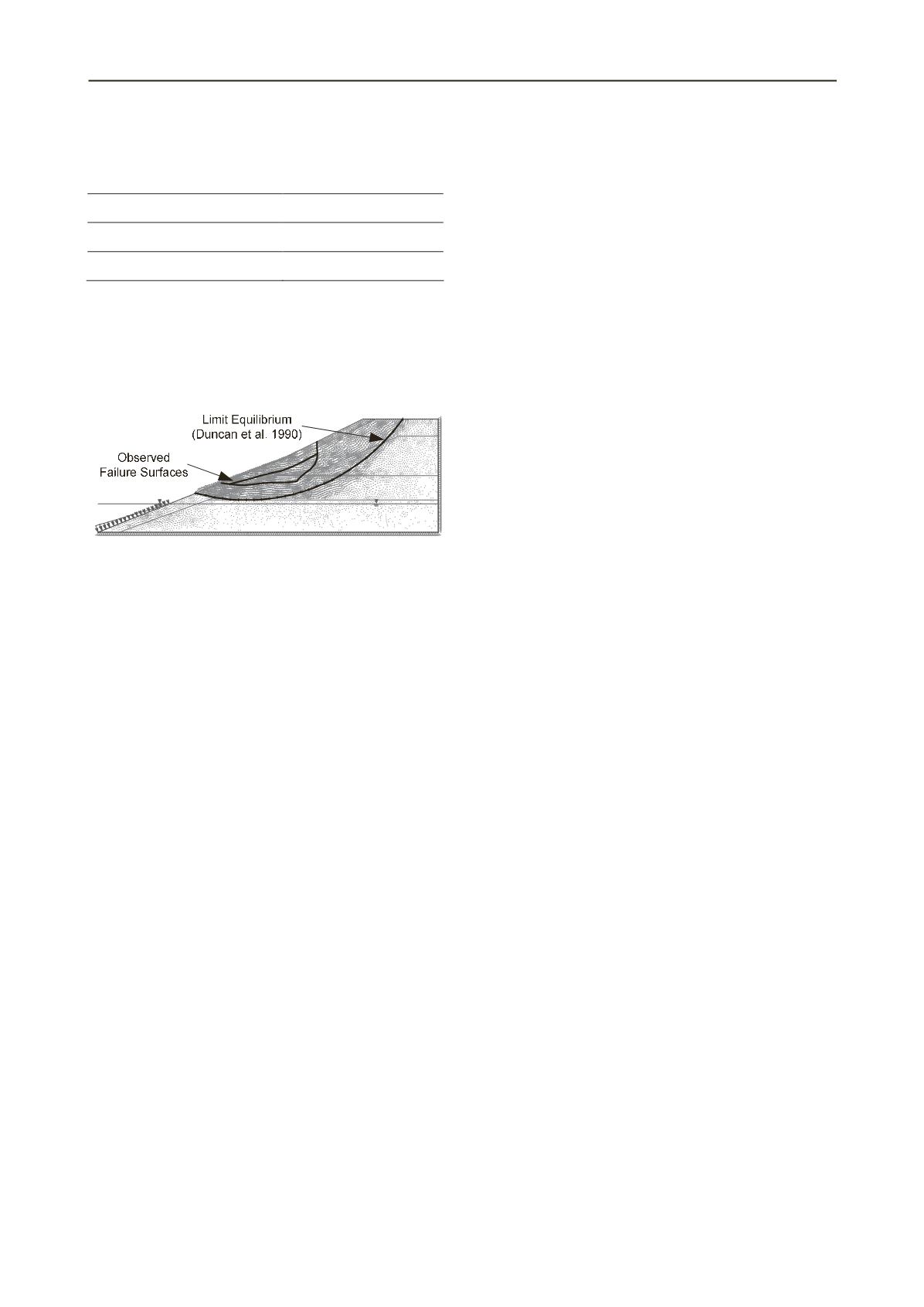
832
Proceedings of the 18
th
International Conference on Soil Mechanics and Geotechnical Engineering, Paris 2013
DWW method and the finite element strength reduction method
with R = 70, as it was for Pilarcitos Dam.
Table 2. Summary of RDD stability analyses for Walter Bouldin Dam
Method of Analysis
Factor of Safety
Finite Element Srength Reduction
with R = 70
1.05
DWW Limit Equilibrium
1.02
In Figure 5, the observed failure surface and the critical
circle from limit equilibrium are superimposed on the nodal
displacement vectors from the finite element analysis. The
methods generate essentially the same result. Both result in
deeper rupture zones than observed in the field. Again, the
cause of this discrepancy is not known.
2
2
Figure 5. Nodal displacement vectors from Walter Bouldin Dam
strength reduction analysis, SRF
crit
= 1.05, R = 70
4 ADVANTAGES AND DISADVANTAGES
Compared to the widely accepted limit equilibrium procedure
for rapid drawdown stability analysis, the proposed finite
element method has a number of strengths and advantages:
•
It follows the conventional approach for analysis of rapid
drawdown and other short-term loading problems by using
total stress stability analysis.
•
The use of the finite element method to determine the
consolidation stress state is an improvement over the use of
limit equilibrium methods for this purpose. In 1960, when
Lowe and Karafiath developed their groundbreaking
method, using limit equilibrium to calculate consolidation
stresses was the only choice. Today, however, with finite
element analyses becoming widely available, it is logical to
use the finite element method for calculation of
consolidation stresses.
•
Representing undrained strength as a function of
’
1c
alone
is a simple means of including the most important factor
controlling undrained strength
–
the major principal
consolidation stress. It makes use of ICU triaxial tests,
which are easy to perform, widely used, and relatively
inexpensive.
•
The reduction factor R is a simple means of adjusting for
differences between the ICU laboratory tests and field
conditions, namely unequal major and minor principal
consolidation stresses, anisotropic strength and deformation
characteristics, compaction prestress effects, and principal
stress rotation from consolidation to failure.
•
The method could be just as easy (or easier) to implement as
limit equilibrium methods once a specific module is
programmed into commercial finite element codes.
Disadvantages of the proposed method include:
•
Finite element strength reduction analysis may not yet be
readily available in all geotechnical engineering
organizations.
•
The recommended value of R = 70, although consistent with
available experience at Pilarcitos Dam and Walter Bouldin
Dam, is based on only two case histories.
•
The shallow failure mechanism observed in RDD failures is
not predicted by the analyses, and the reason for this
discrepancy is not known.
5 CONCLUSIONS
A total stress representation of strength is appropriate for
undrained problems because the very great difficulty in
predicting pore pressures during undrained loading makes it
infeasible to use effective stress analyses for these cases. The
proposed method uses a total stress representation of undrained
strength.
Undrained strength of the embankment soil is characterized
as a function solely of the major effective consolidation stress.
Other factors, such as anisotropic consolidation, principal stress
rotation from consolidation to failure, plane strain conditions,
and laboratory recompression, which also affect undrained
strength, are included in the method through an empirical
adjustment factor, R.
Based on the two best-documented case histories for RDD
(Pilarcitos Dam and Walter Bouldin Dam), it is concluded that a
value of R = 70 is appropriate for both cases. As further cases
become available, they should be examined closely to determine
if R = 70 is appropriate in those cases also.
6 ACKNOWLEDGEMENTS
The authors would like to thank Rocscience Inc. for the research
licenses of Phase
2
and Slide used to perform the finite element
and limit equilibrium analyses. This work was funded by the
Virginia Tech Institute for Critical Technology and Applied
Science, the Virginia Tech Center for Geotechnical Practice and
Research, and the Charles Edward Via Department of Civil and
Environmental Engineering.
7 REFERENCES
Bishop, A. W. (1954). “The
use of pore-pressure coefficients in
p
ractice,”
Geotechnique
, 4(4), 148-152.
Berilgen, M. M. (2007). “Investigation of stability of slopes under
drawdown conditions,
”
Computers and Geotechnics
, 34, 81-91.
Duncan, J. M., Wright, S. G., and Wong, K. S. (1990). “Slope stability
during rapid drawdown,”
Seed Memorial Symposium Proceedings
,
Vol. 2, BiTech Publishers, Ltd., Vancouver, B.C., 235-272.
Griffiths, D. V. and Lane, P. A. (1999).
“Slope stability analysis by
finite elements,”
Geotechnique
, 49(3), 387-403.
Lane, P. A. and Griffiths, D. V.
(2000). “Assessment of stability o
f
slopes under drawdown conditions,”
Journal of Geotechnical and
Geoenvironmental Engineering
, 126(5), 443-450.
Li, C. O. and Griffiths, D. V.
(1988). “Finite element modeling of rapid
drawdown,”
Numerical Methods in Geomechanics
, Innsbruck 1988,
ed. Swoboda, 1291-1296.
Lowe, J. and Karafiath, L.
(1960). “Effect of anisotropic consolidation
on the undrained shear strength of compacted clays,”
Research
Conference on the Shear Strength of Cohesive Soils
, ASCE,
Boulder, CO, 837-858.
United States Army Corps of Engineers (2003).
“Slope stability,
Engineer Manual 1110-2-
1906,” U.S. Army Corps of Engineers,
Washington, D.C.
Wahler, W. A. and Associates (1970). “Upstream slope drawdown
failure investigation and remedial measures, Pilarcitos Dam,”
Report to the San Francisco Water Department
, June 1970, as cited
in Duncan et al (1990).
Whiteside, S. L. (1976). “A study of the rapid drawdown failure in the
Walter Bouldin Dam,”
Technical Report CE-211
, Stanford
University, August 1976, as cited in Duncan et al. (1990).


